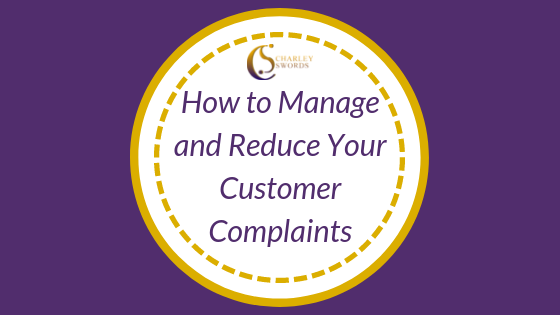All organisations who provide products and services to customers need complaints. Whether they are called complaints, feedback or suggestions – the purpose and benefits of these are the same for your organisation.
Complaints highlight where something is not working as well as expected by your customers, or as well as you thought at management level. Be it in your business processes, how procedures are applied, an issue with your third party provider(s), inconsistency in pricing, poor communications, your customers being treated differently across your multiple delivery channels both online and in physical form or how your staff treat them and speak with them. The list is endless and the opportunities for your customers to complain, provide feedback or make suggestions for change are limitless. It is important that you welcome complaints because they provide direction towards making improvements.
When it comes to handling your customer complaints, it is important to consider them in terms of managing your customer satisfaction. It’s not enough to ‘just get the number of complaints down’ – but it is hugely important to:
- understand the underlying cause of the complaint;
- how it happened;
- how you can correct it;
- how this will ultimately improve the quality of service your customers are receiving.
By understanding the cause of the complaint and correcting it, you are ensuring it does not become a recurring problem, which can skew your statistics and your customer satisfaction levels. Additionally, taking time to understand the cause stops the ‘sticky plaster’ approach to treating only the symptoms.
It is said that 91% of people don’t complain. They prefer to ‘talk with their feet’ by no longer dealing with an organisation that has sold them an inferior product or provided a poor service. More dangerous is the statistic that every dis-satisfied customer shares their bad experience with at least another 10-15 people.
Whatever the reason for your customers complaint, feedback or suggestion for change, you should never underestimate the feelings that lie behind it. What might seem simple at first could turn into something more complex and unpleasant if it recurs.
Make it easy for your customers to complain, so you are sure of getting their honest feedback. Make it easy for them and assure them you want to hear what they have to say. So give them a choice of ways in which to lodge their complaint:
- Have ‘Customer Feedback’ forms and boxes in all your physical outlets and online via your website and various apps. This needs to be a prominent and specific section on your home page, don’t make them work to find it online and don’t expect them to go to your Contact Page. Highlight the importance of their feedback to you.
- Have a Telephone Help Line – freephone if possible – where their complaint can be documented, and where they will be advised of the complaint handling process and ultimately the final outcome.
- Conduct Exit Surveys – face-to-face questions with your customer if they make the decision to never do business with you again.
Have all your employees on-board in terms of understanding how important your customer complaints are! They may not like handling complaints, or dealing with difficult people or indeed, they may not have all the knowledge and training they need to help them in this regard. So it is important you provide them with the skills and tools to manage this:
- Listen actively – don’t interrupt them when they are speaking, nod your head in acknowledging what they are saying, take brief notes, paraphrase back to your customer what you heard them say and get their confirmation of this before you move forward.
- Apologise for the situation and for the upset, inconvenience etc. it has caused your customer. Never apologise for another department or person in your organisation – from the customers perspective, you represent the organisation in its entirety to them. No blame game!
- Confirm your understanding of what or how this might have happened and assure them you will get to the bottom of it.
- Empathise with your customer and explain how you plan to manage their complaint and when you expect you will have a resolution for them.
- Log this complaint in your official complaints system, refer it to the appropriate person or department for resolution and remember to check on progress.
- Follow through to conclusion. Don’t play ‘pass the parcel’ with your customer’s complaint – take ownership of it and closing it out with your customer.
Customer complaints are never easy to hear, but they are crucial for your organisation. If you and your people move from being defensive to open to receiving complaints, feedback and suggestions from your customers, you will be able to effectively reduce them in a sustainable way and improve your customer satisfaction.

Did you find this article helpful?
Let me know what you think about this post in the comments box below.


Thank you Charley
Good read , a relevant refresher.
Thanks Angela – delighted you found it of value!